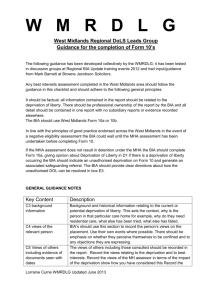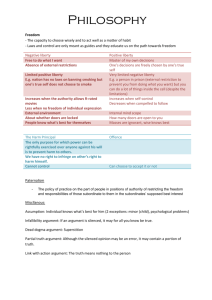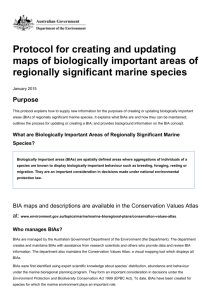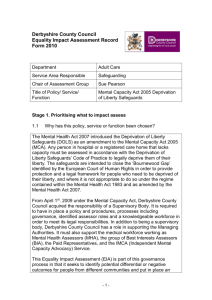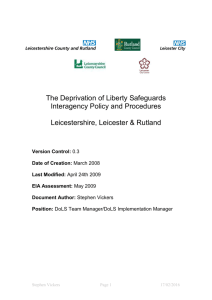Barnsley Guidance & Best Interests FORM10 BOX D5
advertisement
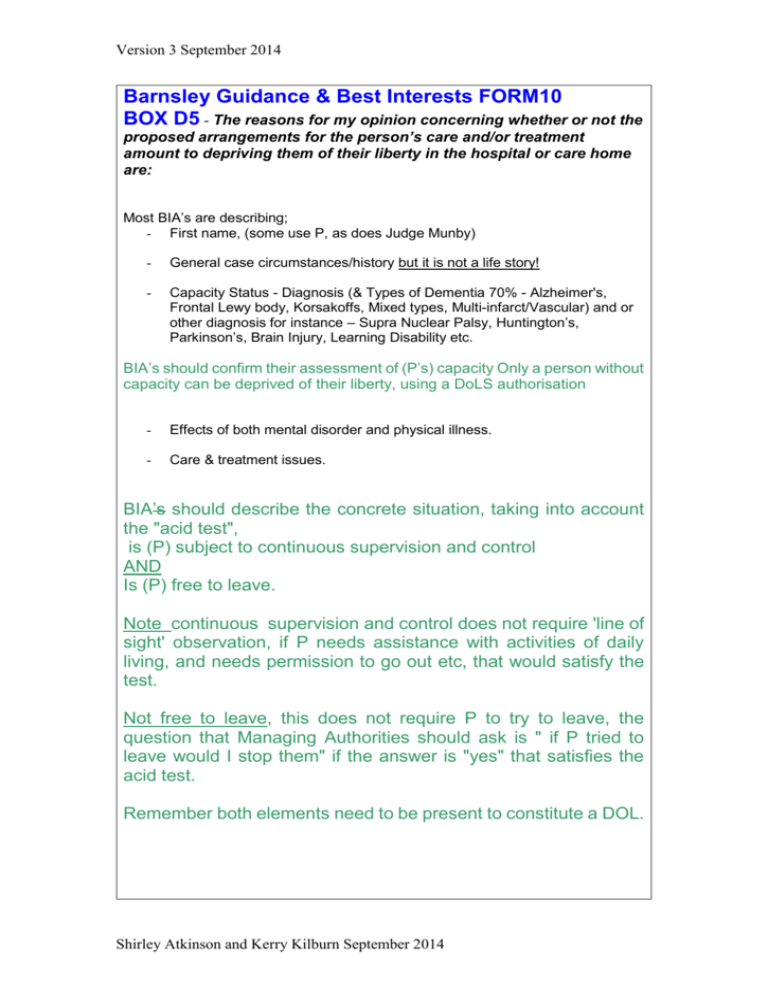
Version 3 September 2014 Barnsley Guidance & Best Interests FORM10 BOX D5 - The reasons for my opinion concerning whether or not the proposed arrangements for the person’s care and/or treatment amount to depriving them of their liberty in the hospital or care home are: Most BIA’s are describing; - First name, (some use P, as does Judge Munby) - General case circumstances/history but it is not a life story! - Capacity Status - Diagnosis (& Types of Dementia 70% - Alzheimer's, Frontal Lewy body, Korsakoffs, Mixed types, Multi-infarct/Vascular) and or other diagnosis for instance – Supra Nuclear Palsy, Huntington’s, Parkinson’s, Brain Injury, Learning Disability etc. BIA’s should confirm their assessment of (P’s) capacity Only a person without capacity can be deprived of their liberty, using a DoLS authorisation - Effects of both mental disorder and physical illness. - Care & treatment issues. BIA’s should describe the concrete situation, taking into account the "acid test", is (P) subject to continuous supervision and control AND Is (P) free to leave. Note continuous supervision and control does not require 'line of sight' observation, if P needs assistance with activities of daily living, and needs permission to go out etc, that would satisfy the test. Not free to leave, this does not require P to try to leave, the question that Managing Authorities should ask is " if P tried to leave would I stop them" if the answer is "yes" that satisfies the acid test. Remember both elements need to be present to constitute a DOL. Shirley Atkinson and Kerry Kilburn September 2014 Version 3 September 2014 Be aware that the following can no longer be considered in deciding if P is subject to a DOL, and do not require any comment, Factors which cannot be taken in account 1) the persons compliance or lack of objection 2) the relative normality of the placement 3) the reason or purpose behind a particular placement Remember The objective component of confinement in a particular restricted place for a not negligible length of time (Storck+ Stanev ) Is relevant And at para 46, Lady Hale says " a Gilded cage is still a cage" And at para 57 “we should err on the side of caution in deciding what constitutes a deprivation of liberty. The factors identified in the following guidance from the code of practice must be read subject to the decision in Cheshire West, even if a factor is now no longer relevant to the question of whether a deprivation is occurring, it is still likely to be relevant for the purposes of identifying whether the package of care or treatment is the least restrictive option available BOX D5 continued page 17 MCA/DOLS Code of Practice each of 7 question 1. Is restraint being used including sedation to admit a person to an institution where the person is resisting admission? (why and how?) 2. Do staff exercise complete and effective control over the care and movement of a person for a significant period. (how?) 3. Do staff exercise control over assessments, treatment, contacts and residence. (how?) 4. A decision has been taken by an institution that the person will not be released into the care of others or permitted to live elsewhere etc (why?) 5. A request by a carer for a person to be discharged to their care is refused (why?) Shirley Atkinson and Kerry Kilburn September 2014 Version 3 September 2014 6. The person is unable to maintain social contacts because of restriction placed on their access to other people (why?) 7. The person loses autonomy because they are under continuous supervision and control (how?). Considering all these issues in Box D5 the BIA should confirm in their opinion if this is a Deprivation of Liberty BOX D6 If the proposed arrangements amount to depriving the person of their liberty, the reasons for my opinion that they are, or are not, in the person’s best interests are: Is this deprivation of liberty in P’s best interests? You should consider the following: The best interest principles as set out in s1(5) of the MCA 2005; The statutory best interests checklist as set of in s4 of the MCA – 2005 and in Chapter 5 of the MCA-CoP; The additional factors in Para 4.61 of the DoLS CoP; The care and treatment issues; Are there any less restrictive alternatives? What is the issue of ‘magnetic importance’? What are the viable alternatives? Do P’s best interests conflict with another’s best interests? Are there specific cultural issues? What are the views of the Mental Health Assessor? Refer to the Best Interests care plan; Are there any safeguarding issues? P’s mental capacity for decision making; P’s wishes and feelings; P’s family and carers wishes and feelings. For more complex and borderline cases BIA’s should consider the Balance check list evidence approach as advocated by Neil Allen Barrister In February 2012 BIA’s should record who they have consulted and record their views! Shirley Atkinson and Kerry Kilburn September 2014 Version 3 September 2014 BOX D7 If the proposed arrangements amount to depriving the person of their liberty, the reasons for my opinion that they are, or are not, necessary in order to prevent harm to the person are: It was initially found the BIA’s were perhaps not fully reading the question answering the DOLS issue but not describing how harm would be prevented. Please describe your opinion of ways that harm would be prevented, which may include; Treatment (what would happen without treatment?) + List of Treatments list of outcomes. Condition management (describe deterioration?) Mobility issues ( falls and risk etc!) Continence (outcomes if not maintained?) Administration of medication (outcomes if the person cannot maintain?) Food and fluid needs etc. (outcomes if the person cannot/does not maintain?) Personal Care/hygiene (outcomes if the person cannot maintain?) Any other issues? Shirley Atkinson and Kerry Kilburn September 2014 Version 3 September 2014 BOX D8 If the proposed arrangements amount to depriving the person of their liberty, the reasons for my opinion that they are, or are not, a proportionate response to the likelihood of the person otherwise suffering harm and the seriousness of that harm are: Lord Sir James Mumby at YAMHP Conference in Leeds on 10th Feb 2012 was clear in his view that the first issue to be addressed is Article 8 Rights to Private & Family Life and then Article 5 (Right to Liberty (Personal Freedom) Article 8 is of particular interest to BIA’s as it confers positive rights on the citizen and imposes on the state positive duties and obligations both substantive and procedural. The states duty therefore is to respect private and family life and take positive steps not to do so! There is increasing evidence that BIA’s are now describing why private and family life is being affected and the need for a DOL? Article 5 Right to Liberty (Personal Freedom) BIA’s are now offering a description of their opinion that any decisions are appropriate and a necessary response in each case (i.e. DOLS being appropriate to prevent harm to the person and is an appropriate response to the likelihood and seriousness of that harm! BIA’s should describe why? “PLEASE NOTE!!!! In the London Borough of Hillingdon & Neary case Judge Jackson stated that assessors act as individual professionals and are personally accountable for their decisions & best interests should be seen as a corner stone of the protection that the DOL safeguards offer to people facing a deprivation. He referred to the urgent and first standard authorisation as “flawed” a further period of assessment the best interest’s assessment “was an even flimsier document” and was critical of other periods of best interest assessments. Judge Jackson in Blackburn with Darwen Borough Council Dec 2011 confirmed that “Authorisations must be founded on sound assessments” If BIA’s follow this guidance your assessments should be sound and neither flawed or flimsy Shirley Atkinson and Kerry Kilburn September 2014
